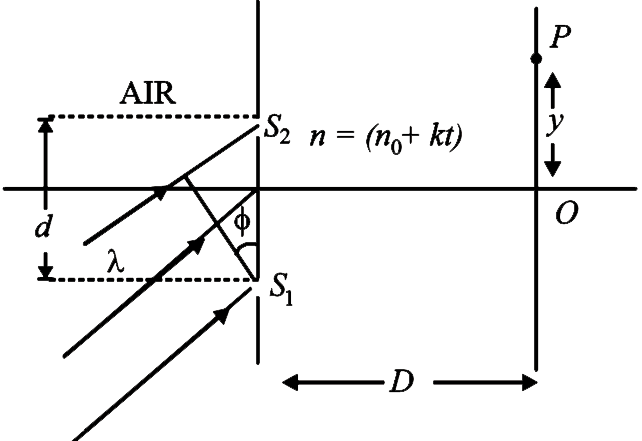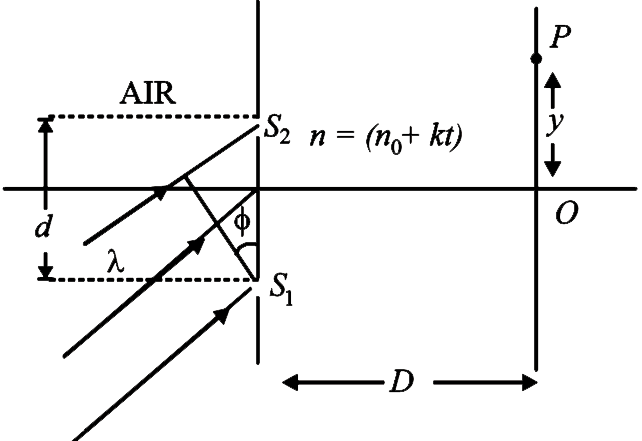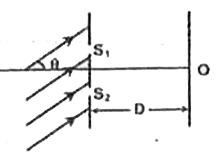In a Young’s double slit experiment a monochromatic light whose wavelength is l strikes on the slits, separated by distance d, as shown in the figure. Refractive index of the medium between slits and screen varies with time t as n = n0 + kt. Here n0 and k are positive constants. Position of any point P on screen is measure by its y-coordinate as shown.

If a glass plate of small thickness b is placed in front of S1. How should its refractive index vary with time so that central maxima is formed at O.
n0+kt+2dsinϕb
n0+kt−2dsinϕb
n0+kt−dsinϕb
n0+kt+dsinϕb
Step by step video & image solution for In a Young’s double slit experiment a monochromatic light whose wavelength is l strikes on the slits, separated by distance d, as shown in the figure. Refractive index of the medium between slits and screen varies with time t as n = n0 + kt. Here n0 and k are positive constants. Position of any point P on screen is measure by its y-coordinate as shown. If a glass plate of small thickness b is placed in front of S1. How should its refractive index vary with time so that central maxima is formed at O. by Physics experts to help you in doubts & scoring excellent marks in Class 12 exams.
Topper's Solved these Questions
Similar Questions
In a Young’s double slit experiment a monochromatic light whose wavelength is l strikes on the slits, separated by distance d, as shown in the figure. Refractive index of the medium between slits and screen varies with time t as n = n0 + kt. Here n0 and k are positive constants. Position of any point P on screen is measure by its y-coordinate as shown.

The y co-ordinate of central maxima at any time t isView SolutionIn a Young’s double slit experiment a monochromatic light whose wavelength is l strikes on the slits, separated by distance d, as shown in the figure. Refractive index of the medium between slits and screen varies with time t as n = n0 + kt. Here n0 and k are positive constants. Position of any point P on screen is measure by its y-coordinate as shown.

The velocity of central maxima at any time t as a function of time t isView Solution
Knowledge Check
- Question 1 - Select One
In a Young's double slit experiment, the central point on the screen is
ABrightBDarkCFirst bright and then darkDFirst dark and then bright - Question 2 - Select One
In Young's double slit experiment parallel monochromatic light is incident on both the slits at an angle as shown in the figure. To obtain the central maxima at on the screen we can
 Aplace a thin glass sheet of appropriate thickness in front of slit S1.Bplace a thin glass sheet of appropriate thickness in front of slits S2Csubmerge the whole experimental setup in appropriate liquid.Drotate the plane of slits by angle 6 anticlockwise
Aplace a thin glass sheet of appropriate thickness in front of slit S1.Bplace a thin glass sheet of appropriate thickness in front of slits S2Csubmerge the whole experimental setup in appropriate liquid.Drotate the plane of slits by angle 6 anticlockwise - Question 3 - Select One
In a Young's double slit experiment (slit distance d) monochromatic light of wavelength λ is used and the figure pattern observed at a distance L from the slits. The angular position of the bright fringes are
Asin−1(Nλd)Bsin−1⎛⎜ ⎜⎝(N+12)λd⎞⎟ ⎟⎠Csin−1(NλL)Dsin−1⎛⎜ ⎜⎝(N+12)λL⎞⎟ ⎟⎠
In a Young's double slit experiment, (slit distance d) monochromatic light of wavelength λ is used and the fringe pattern observed at a distance D from the slits. The angular position of the bright fringes are
View SolutionIn the Young's double slit experiment using a monochromatic light of wavelength λ, the path difference (in terms of an integer n) corresponding to any point having half the peak
View SolutionIn a Young’s double slit experiment, the separation of the two slits is doubled. To keep the same spacing of fringes, the distance D of the screen from the slits should be made
View SolutionYoung’s double slit experiment is performed with light of wavelength 550 nm . The separation between the slits is 1.10mm and screen is placed at distance of 1 m . What is the distance between the consecutive bright or dark fringes
View SolutionIn a Young's double slit experiment, the separation of the two slits is doubled. To keep the samme spacing of fringes, the distance D of the screen from the slits should be made
View Solution

